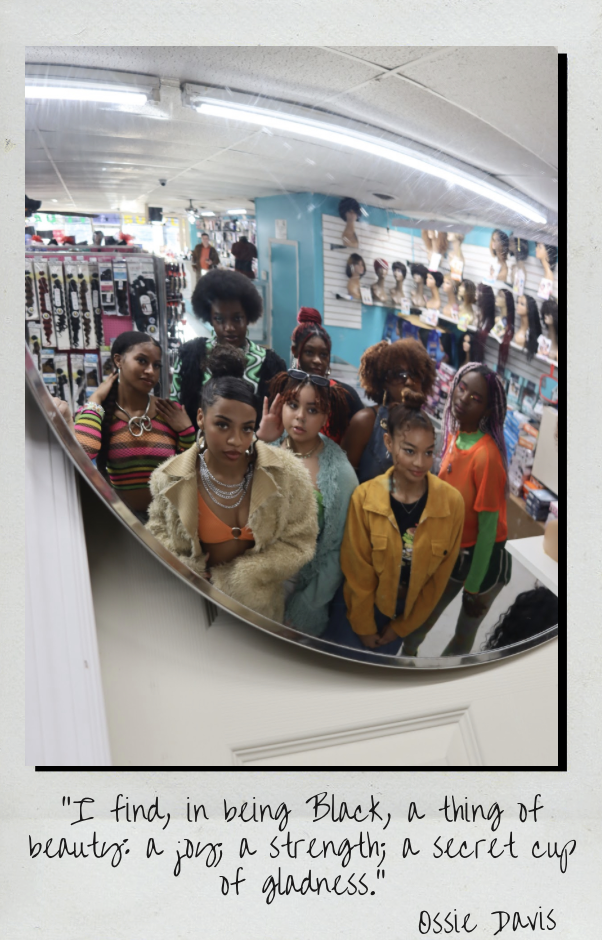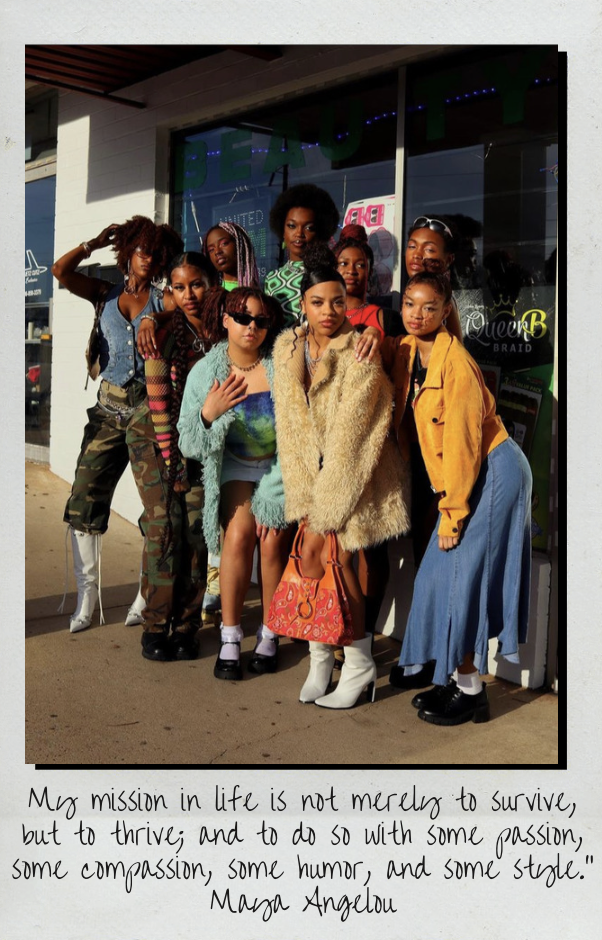Black Fashion: Revolution and the Somatics of Joy and Pleasure
by Sha'Mira Covington
### A meditation by Dr. Sha’Mira Covington
For Black folx, getting dressed is a powerful political act that transforms cultural and political landscapes. Take for instance, images from the 1960s and 70s of civil rights activists dressed in their Sunday’s best at protests to combat white conceptions of Blackness; or the Black Panther Party’s use of all black clothing to emphasize Black pride. While there is often attention given to social movements that focus on policy issues, the fight to integrate public spaces, and big sociopolitical events, such as marches and protests, there are also everyday acts such as dressing our bodies that are integral to understanding how everyday people participate in revolution. Fashion and style connect people to global movements for Black liberation and this connection warrants inclusion in what’s considered a revolutionary act. 
Cultural discourses about Blackness often starts with the body. This is because Black bodies have always been a hegemonic obsession in the West (think slavery, labor, death, etc). This is also because Black fashion is an embodied language that Africana people use to rebuild our psyches and heal emotional and physical wounds from the imperialist white supremacist capitalist heteropatriarchy. Wearing our natural hair, doning a dashiki, or highlighting our melanated skin, are all nods to the African continent and go against hegemonic white norms. Despite the violent environment in which Black fashion and embodied narratives are created, this cultural production is filled with joy and pleasure. Clothesare not just garments by which we adorn our bodies. Black fashion and dress are companions to Black struggle and liberation. They provide commentary about state-sanctioned violence and are historical markers associated with Black embodied practices. Therefore, Black fashion is situated in Black revolution; and Black revolution includes joy and pleasure. 
Joy and pleasure are acts of resistance because they are a form of “energy for change,” as Audre Lorde puts it. They counter and contrast the rigidity and control of hegemonic oppressive structures. Fashion serves as a tool for creating a culture of joy, pleasure, and play. Through dressing our bodies, the internalized dynamics of oppression that we absorb and learn are transgressed. Black folx often utilize narratives of the body to connect personal stories of oppression to collective historical stories and protest. The body then, acts as a release point with fashion serving to aesthetically articulate protest. At the same time, fashion is the “inner voice”, outwardly displayed in the quest for liberation. Black fashion also allows for play. This play is a way for us to daydream new realities for our bodies. Black fashion plays with color, patterns silhouette, and old vs new. There is a vibration of hope, enjoyment, and rejoice in how we adorn our bodies. This vibration offers a naming for radical Black praxis. As an intrusion on Black violence, degradation, and oppression, the aesthetic, has historically elucidated the somatics of joy and pleasure as resistance. Black fashion, across the diaspora, forms a theoretical framework for revolution, past and present. 
With this said, it’s important to note that fashion is not independent from structures of oppression. The fashion-industrial complex is one of the largest culprits of global capitalism and exploitation. The general development of it is intertwined with histories of Indigenous genocide, the transatlantic slave trade, and environmental warfare. Those legacies are still apparent today. Mainstream fashion feeds on Blackness, commodifying and exploiting it. “Sustainable” fashion, too, pilfers theory and praxis of Black and Indigenous folx, who have cared about and tended to the natural environment around us for centuries. If we look to Black fashion, we can see that the range of “sustainable” social and political practices are historically rooted in the experiences of Black and Indigenous folx. Thus, by centering Black bodies as sites of knowledge production, which is integral to the liberation from cultural, social, and historical oppressions enacted on them, we can challenge what it means to “do” revolution. If we look to Black fashion, with history in mind, as a tool for play that functions to satisfy one’s high-order desires, such as self-expression, having fun, and critiquing narratives of the body, fashion can serve as both an inward and outward gaze of revolution.
Regarding Blackness and liberation, the only validation of personhood seems to come out of pain and struggle, but almost never through joy and pleasure. Black stories are typically told by positioning us as victims of tragic circumstances but rarely as agents of change in our personal lives or the world around us. Reclaiming fashion as a revolutionary tool imbues Black liberation with complexity, imagination, personal power, joy, and pleasure. Looking to Black fashion and dress as a primary somatic process, one that is tied to psychological and spiritual freedoms is to release it from the damaging and enmeshed systems of colonial visual exposure and corporeal violence. Fashion as a visual form of resistance allows Black folx to enact joy and pleasure on our own terms. 
Acknowledgement
Thank you to the amazing undergraduate students of HAUTE Creatives Agency at The University of Georgia for photo contributions. IG: @hauteuga, TikTok: @hauteuga
Sha'Mira Covington
Sha’Mira Covington is a Ph.D. candidate in the Department of Textiles, Merchandising and Interiors and the Institute for African American Studies at the University of Georgia. Her research explores fashion as an embodied cultural, historical, social, and political phenomenon involved in and affected by histories of colonial domination, anti-colonial resistance, and processes of decolonization and globalization. Her personal, artistic, and spiritual work is informed and guided by her ancestors, communities in which she lives, nature, Spirit, and love.




